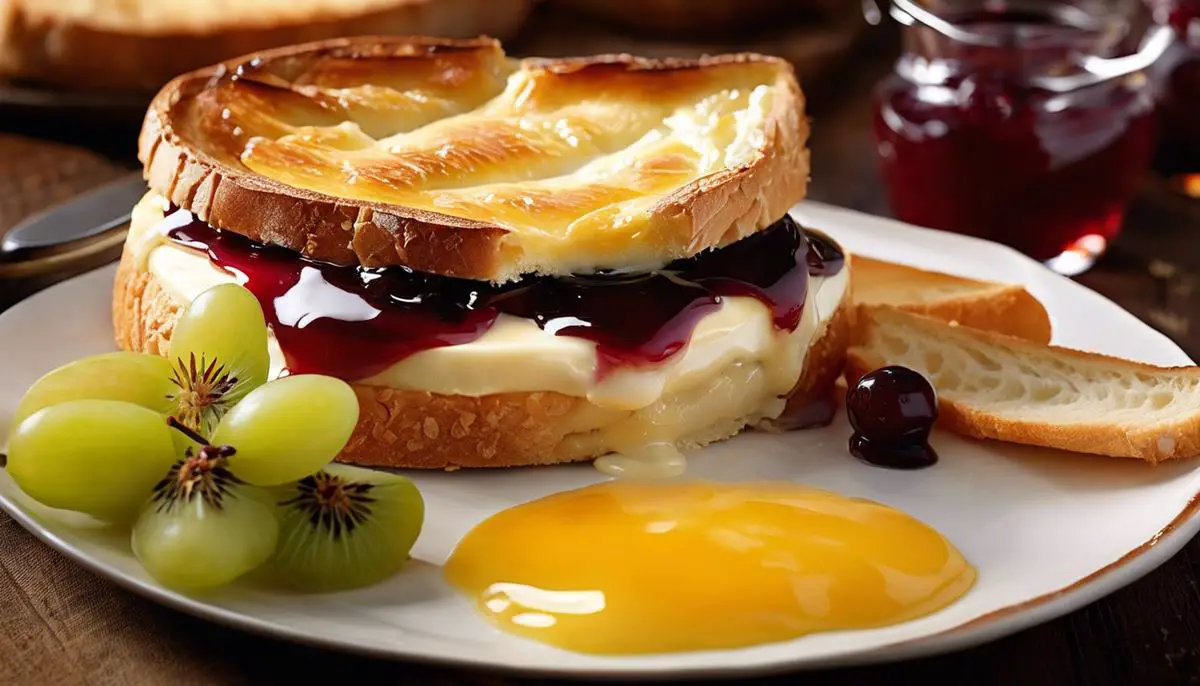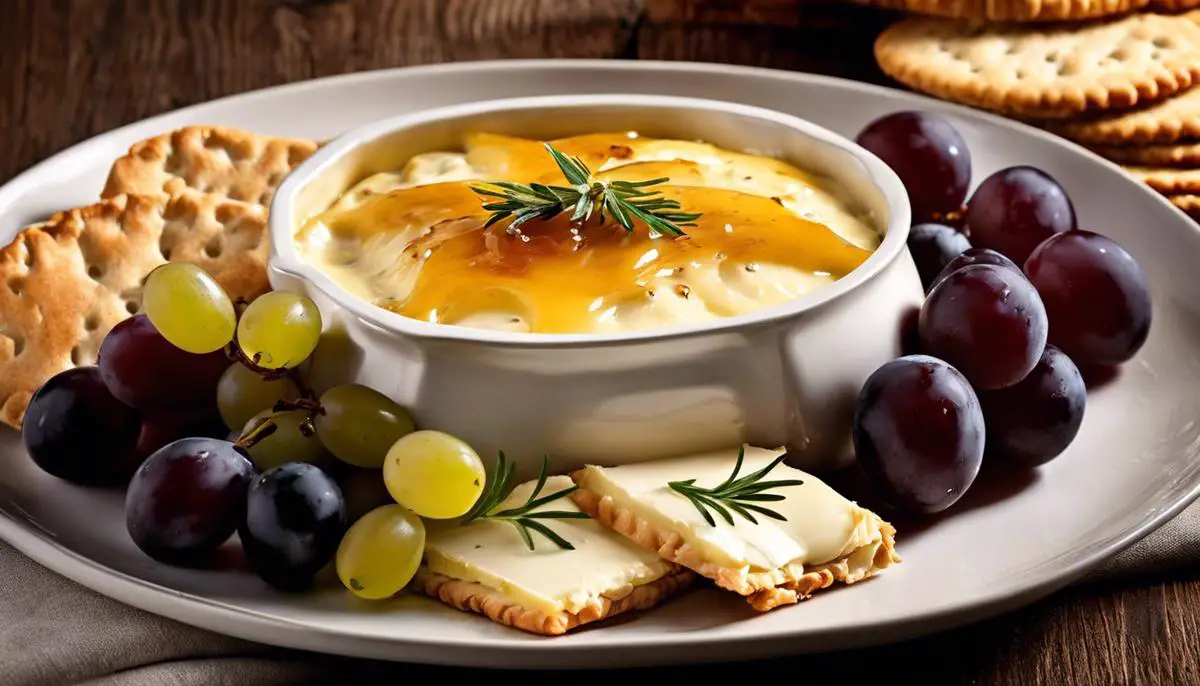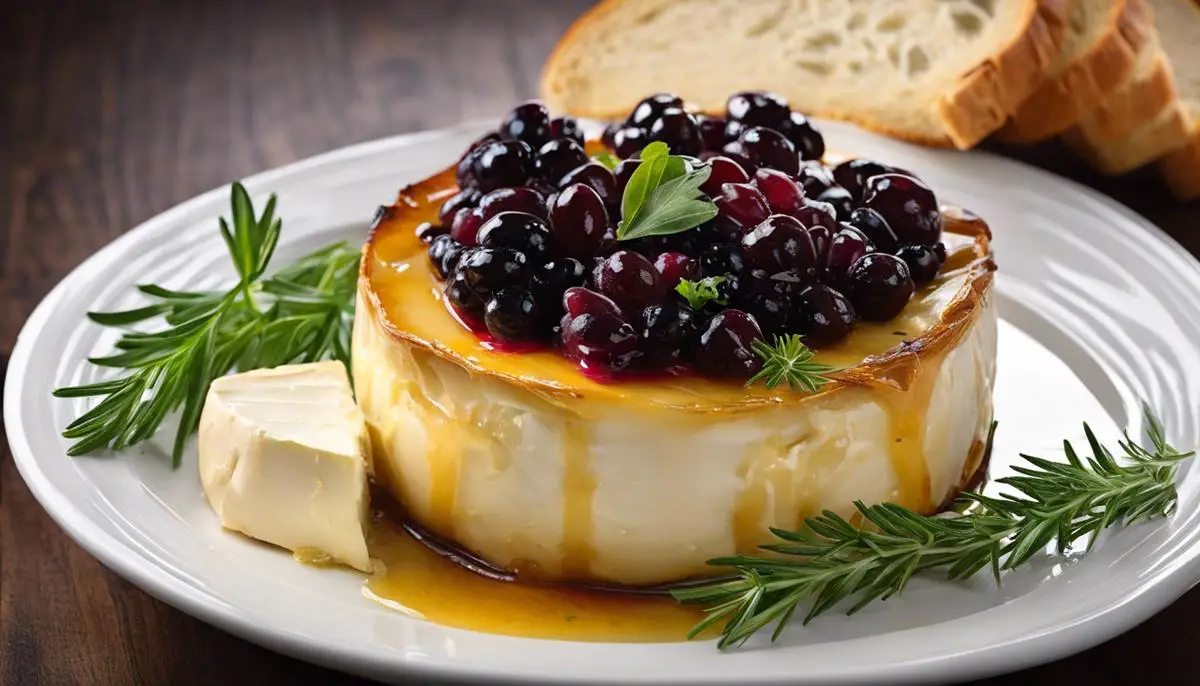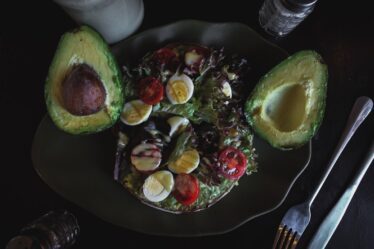
The tantalizing flavor fusion of baked brie with fruit preserves provides a dish that is both decadent and irresistible. As you embark on this culinary journey, it’s essential to recognize the starting point, which involves choosing a quality brie. The texture and character of the brie you choose may very well be the determining factor of how enjoyable the final result will be. Next, prepare yourself to delve into the realm of fruit preserves and how their varying flavors can either enhance or diminish your baked brie experience. This process may seem daunting, but with the right knowledge and understanding, creating your perfect baked brie can be as easy as pie. As you venture further, you’ll unravel the mysteries behind baking parameters that result in the perfectly creamy and gooey brie, and the most effective ways to invite your guests to indulge with appealing presentation tactics.
Choosing Quality Brie
A Connoisseur’s Guide to Choosing Brie for Baking
A bottle of wine or a box of bonbons might woo some, but for a true culinary heart, nothing is as captivating as the creamy, melt-in-your-mouth decadence of baked Brie. This French cheese, a dreamy fond of sophisticated and subtle flavors, has long been an adored gem in gourmet treasures.
Choosing Brie for baking is both an art and a science, and these guidelines are the compass to navigate the maze of gourmet cheese stores.
Firstly, go for genuine Brie, because let’s face it, there’s is no substitute for authenticity. Brie de Meaux and Brie de Melun are prestigious varieties that bear the Appellation d’origine contrôlée (AOC), a French certification meaning “the one and the original.” They are crafted with raw cow’s milk and aged for a minimum of four weeks, leading to their creamy texture and rich flavor.
When it comes to selecting the right Brie for baking, size matters. Small vs large wheels: smaller wheels are more intense in flavor and tend to be creamier. This is because the ratio of the bloomy rind to the cheese inside is higher in smaller wheels, impacting the overall taste and texture.
Next up, maturity is key. The aging process significantly determines the flavor profile of the Brie. Young Brie, aged only a few weeks, boasts a firm texture and mild, buttery flavor. As the Brie matures, it develops fruity and earthy notes and a gooey, spoonable texture. For baking, young to moderately aged Brie is recommended. It’s milder in flavor and melts gorgeously while aged Brie might overwhelm other flavors and could turn too runny.
Don’t disregard the rind. A healthy Brie has a rind that is soft, bloomy and white, sometimes with small red or brown spots. However, dark spots, cracks, or a heavy ammonia smell are all red flags indicating an overly ripe or improperly stored Brie.
In the world of Brie, firmness spells quality. Hard, chalky centers are indicative of an under-ripe Brie that won’t soften enough when baked. Conversely, overly soft or liquid consistency reveals an over-ripe Brie that would likely go too runny in the oven. The sweet spot is a Brie that yields to light pressure, signaling it will transform into a perfect, creamy melt upon heating.
Finally, remember, in the passionate pursuit of flavor, don’t be afraid to ask questions. Your local cheesemonger is a wellspring of knowledge. Ask for their recommendations, inquire about the cheese’s origin, and don’t shy away from requesting a sample. They are usually more than happy to guide enthusiastic food-lovers through their cheese odyssey.
Selecting the perfect Brie for baking is a delightful endeavor, akin to a quest for a deliciously melty holy grail. When finally that luscious cheese oozes out from the oven, the result achieved from being choosy is all worth it – a true food lover’s delight that spells sophistication and comfort in every bite. Enjoy the journey!

Preparing the Brie and Preserves
An Epicure’s Guide: Baking Brie with Fruit Preserves
A well-executed Brie cheese and fruit preserve pairing invites an exquisite harmony of flavors. It incites a truly unforgettable journey across the palate. As you prepare for this seemingly simple yet quite profound culinary endeavor, it’s crucial to approach it with thoughtfulness and precision.
To start, opt for fruit preserves that elevate the Brie’s inherent qualities. An aptly selected preserve often brightens the velvety cheese’s rich, buttery qualities, while balancing its earthy undertones. Fruit preserves with a balmy sweetness uphold the Brie’s creaminess impeccably. Cranberry, fig, and apricot preserves are classics, while more adventurous choices like peach chili or raspberry chipotle add a surprising kick to the mix.
Before you transport your beloved Brie wheel to the baking dish, creating a little pocket for the preserve will maximize flavor absorption. Slice a circular lid off the top of your Brie, making sure to keep it intact. Use a spoon to gently hollow out the center of the wheel, creating a small well.
Next, you have your preserve at the ready, spoon it with love into your beautifully crafted Brie cavity. This process not only ensures a perfect proportion of Brie to preserve in each bite, but also intensifies the amalgamation during baking. Don’t discard the lid you cut earlier; gently replace it to protect your preserve-brie amalgamation.
Baking Brie should be done with utmost grace. Preheat your oven to 350°F to ascend it on a steady and gentle heat journey. Aesthetically arrange the filled Brie on a sheet of parchment paper on a baking sheet, keeping the preserve-laden top up. Allow this delicacy to bask in the oven’s warmth for about 15 to 20 minutes. Observe it carefully, for the aim is to achieve a perfectly ‘runny’ texture without it collapsing entirely.
Often underestimated, the cooling period of the baked Brie plays an equally vital role. After it’s carefully taken out of the oven, let the Brie rest and regain its composure for a good five to ten minutes. The cooling period allowing for a bit of setting, makes it easier to transfer onto your serving platter without compromising its elegance.
Lastly, add a sprig of rosemary or a sprinkle of crushed pistachios for an aesthetically pleasing garnish that compliments the flavors. Slice a baguette, arrange some crackers, and let your friends indulge in the delectable symphony of baked Brie and fruit preserves.
Baking Brie with fruit preserves is a gastronomic experience that transcends beyond the realms of everyday cooking. When done with care and precision, it morphs into a delightful opportunity to share an intimate connection with your loved ones through the language of sublime flavors.

Baking and Serving Brie
In the bustling kitchen of any passionate food enthusiast, knowing how to bake Brie cheese perfectly is indeed a coveted skill. It’s not just about the oven’s heat, but the precise timing and presentation methods that elevate the Brie wheel into a sublime shared culinary experience.
When it comes to baking this prestigious cheese, the clock is an essential apparatus, second only to the oven. While a nobly matured, quality Brie basks in the heat, it can take a mere 10-15 minutes under a temperature of 350°F (175°C) to reach the desired creamy consistency. An overbaked Brie can split or become too runny, a tragedy for any Brie lover.
However, different sizes of Brie call for some variation in timing. Petite varieties will need less time in the oven, roughly around 7-10 minutes, while the larger sizes might take up to 20 to achieve the same divine texture and gooeyness. Therefore, keep an eager eye on the oven, and a keen sense of intuition, as the Brie morphs from solid to liquid glory.
But, anyone who’s has the pleasure of indulging into baked Brie will know it’s not just about the cheese. It’s the marriage of Brie with different accompaniments that create the delightful blast-off flavors. Whether you’ve gone for the fruit preserve filling or a hint of truffle oil, remember the accompaniments stand as equals to the Brie under the heat and have a role to play.
Brie, fresh out of the oven, requires an anticipative wait to cool for at least 5 minutes before it’s ready to be served. This is an exercise in patience, for cutting into the warm cheese prematurely can lead it to lose its shape and the consistency may be too runny. Brie should be served warm, not hot, to enjoy its full range of flavours and texture.
The canvas of a beautifully baked Brie provides endless creative opportunities for garnishing. Fresh herbs like basil or rosemary, a sprinkle of toasted nuts or even a drizzle of honey can escalate your baked Brie to an aesthetic piece of edible art. Remember, we eat with our eyes first!
Baked Brie struts its charm best when accompanied by warm crusty bread or crispy crackers. Ensure that they are baked freshly or sourced from your trusted bakery. A light toasting can enhance the flavor experience. Although Brie is versatile, matching it with the right type of bread or cracker, forms an indispensable triad of taste dimensions.
The gastronomic journey of experiencing baked Brie is unique to each of us. The feelings of the smooth rind giving way to the hot, gooey interior. The harmony of flavors playing on the palate, shared laughter, stories and memories woven together, much like the threads of melted Brie on a crispy cracker. That, dear food lovers, is the real magic of baking Brie, a tradition that captures not just taste, but transcends into a sentimental culinary adventure.
So, go ahead and let the delicious journey of baking Brie commence!

Having traversed through a wealth of knowledge on baked brie with fruit preserves, you’re now equipped with understanding and practical skills to create a culinary masterpiece. The importance of selecting a quality brie that will yield the best taste and texture can’t be overstated. We’ve discovered how scoring the rind and adding fruit preserves impacts the outcome and learned to identify the flavors that are most compatible. With insights on the ideal oven temperature and baking time, you’re now ready to create a perfectly melted brie. Finally, mastering the art of serving this dish in an appealing fashion can be a finishing touch that leaves a lasting impression. Take pride in the mastery of these aspects and find enjoyment in the process as much as in the satisfaction of those who partake in this indulgent dish.



